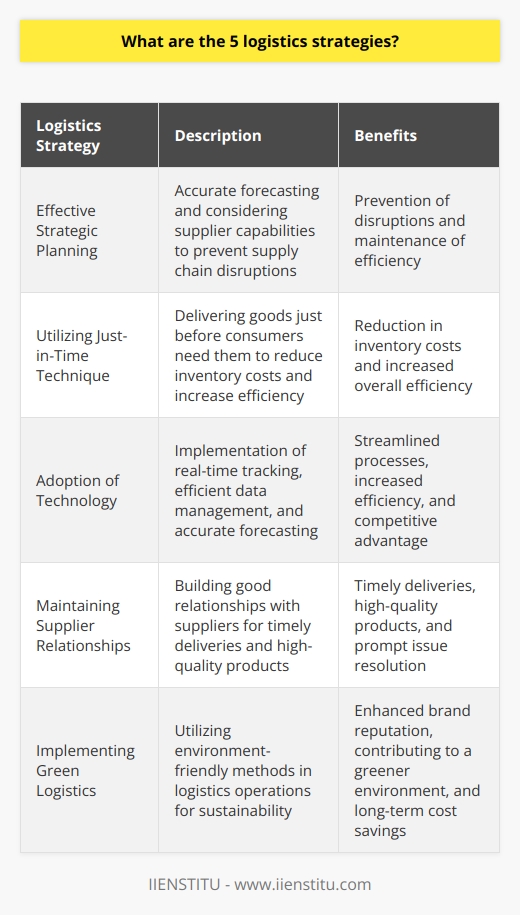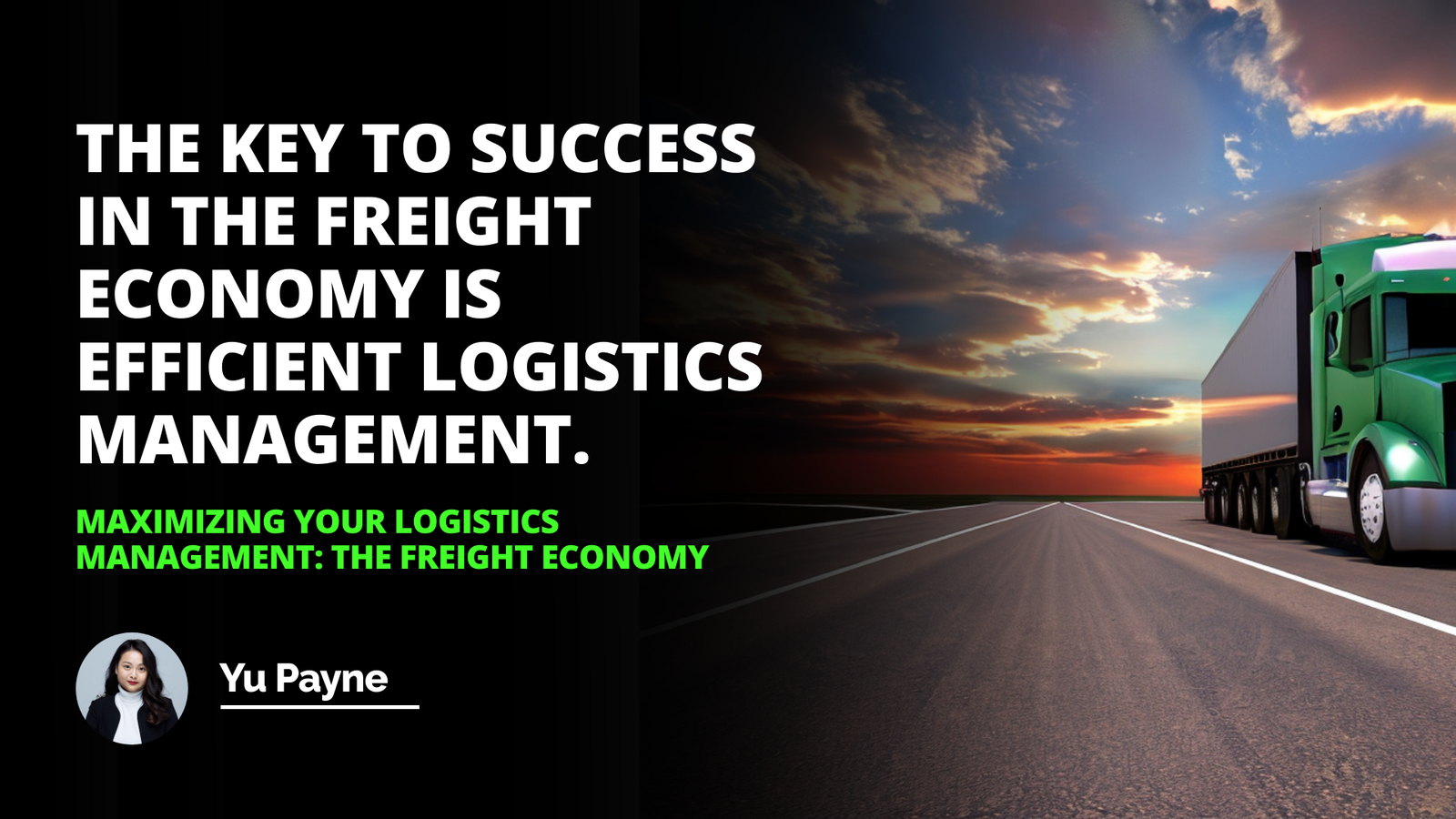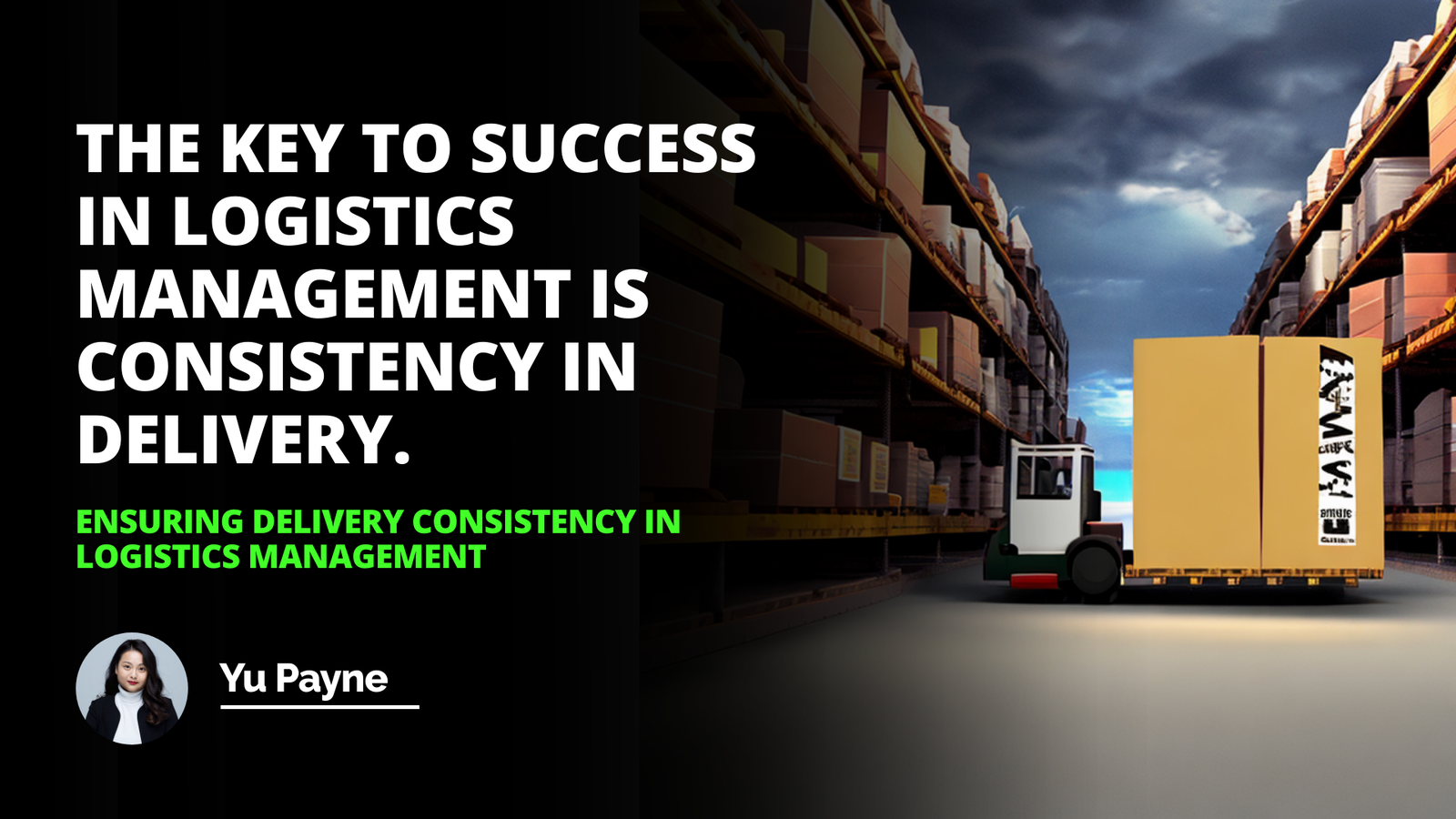
As a young professional just starting out in the logistics industry, I was eager to make my mark in supply chain management. One of the first challenges I faced was understanding the intricacies of carload freight and how it fit into the larger picture of the supply chain. Little did I know that this mode of transportation would become a cornerstone in optimizing supply chain processes for many businesses.
Overview of Carload Freight in Supply Chain Management
Benefits of Carload Freight in Supply Chain Management
Overview of Carload Freight in Supply Chain Management
Benefits of Carload Freight in Supply Chain Management
Challenges of Carload Freight in Supply Chain Management
Strategies for Optimizing Carload Freight in Supply Chain Management
Impact of Carload Freight on the Future of Supply Chain Management
Carload freight offers numerous benefits in the realm of supply chain management. By utilizing this transportation method, companies can:
1- Reduce costs: Shipping full carloads allows for lower per-unit costs compared to less-than-truckload (LTL) shipments.
2- Improve efficiency: Streamlined loading and unloading processes, coupled with direct routes, lead to faster transit times.
3- Minimize environmental impact: Fewer trips and optimized fuel usage contribute to a reduced carbon footprint.
Christopher (2016) emphasizes the importance of cost-effective and efficient logistics in Logistics & Supply Chain Management, noting that carload freight can be a key player in achieving these goals.
Challenges of Carload Freight in Supply Chain Management
Despite its advantages, carload freight is not without its challenges. Some of the primary hurdles include:
Vehicle selection difficulties: Finding the right vehicle that can accommodate the specific needs of the cargo can be tricky.
Loading and unloading complexities: Handling large shipments often requires specialized equipment and skilled personnel.
Infrastructure limitations: Not all facilities are equipped to handle carload freight, which may necessitate investments in upgrades.
Bowersox, Closs, and Cooper (2013) discuss these challenges in Supply Chain Logistics Management, highlighting the need for careful planning and adaptability when dealing with carload freight.
Strategies for Optimizing Carload Freight in Supply Chain Management
To make the most of carload freight, companies should implement strategic measures such as:
1- Selecting the appropriate vehicle: Carefully assess cargo needs and partner with reliable carriers to ensure the best fit.
2- Enhancing loading and unloading processes: Invest in modern equipment, train staff, and adhere to safety protocols for improved efficiency.
3- Route optimization: Utilize routing software, monitor traffic conditions, and plan for contingencies to minimize delays.
4- Embracing technology: Implement supply chain management software, IoT devices, and data analytics to streamline operations and identify areas for improvement.
Murphy and Knemeyer (2018) explore these strategies in Contemporary Logistics, emphasizing the role of technology in optimizing carload freight management.
Impact of Carload Freight on the Future of Supply Chain Management
Looking ahead, carload freight is poised to play an even more significant role in the future of supply chain management. Advancements in technology, such as autonomous vehicles and enhanced tracking systems, will make carload freight more efficient and reliable. As Simchi-Levi, Kaminsky, and Simchi-Levi (2008) discuss in Designing and Managing the Supply Chain, staying ahead of technological innovations is crucial for success in the competitive world of supply chain management.
Furthermore, the growing emphasis on sustainability will drive the adoption of eco-friendly practices in carload freight. Companies that prioritize environmental considerations, such as using electric or hybrid vehicles and reducing waste, will not only help the planet but also appeal to environmentally conscious consumers.
In a globalized economy, carload freight offers the flexibility needed to navigate cross-border shipping complexities and respond to market fluctuations. Ballou (2004) highlights the importance of resilience planning in Business Logistics/Supply Chain Management, noting that carload freight can be a valuable tool in preparing for disruptions like natural disasters or pandemics.
Conclusion
Reflecting on my journey with carload freight, I realize how integral it has become in supply chain management. From my early challenges to witnessing its evolution, it's clear that when leveraged correctly, carload freight can transform operations.
To summarize, the key takeaways are:
1- Understand the basics: Know what carload freight is and how it fits into the logistics definition.
2- Recognize the benefits: Cost savings, efficiency, and environmental advantages.
3- Navigate the challenges: Be proactive in addressing potential obstacles.
4- Implement optimization strategies: Use technology and best practices to enhance performance.
5- Look to the future: Stay informed about trends and innovations.
By embracing these principles, businesses can enhance their supply chain management, positioning themselves for success in an ever-changing landscape. As Christopher (2016) notes, "The key to success in today's competitive environment is the ability to respond rapidly and cost-effectively to changes in the marketplace." Carload freight is undeniably a powerful tool in achieving this goal.
References
1- Christopher, M. (2016). Logistics & Supply Chain Management. Pearson Education Limited.
2- Bowersox, D. J., Closs, D. J., & Cooper, M. B. (2013). Supply Chain Logistics Management. McGraw-Hill.
3- Murphy, P. R., & Knemeyer, A. M. (2018). Contemporary Logistics. Pearson.
4- Simchi-Levi, D., Kaminsky, P., & Simchi-Levi, E. (2008). Designing and Managing the Supply Chain: Concepts, Strategies, and Case Studies. McGraw-Hill.
5- Ballou, R. H. (2004). Business Logistics/Supply Chain Management. Pearson Education.
Unpacking carload freight in supply chain management is indeed complex, but as I've learned, the rewards are absolutely worth the effort. By understanding the benefits, navigating the challenges, and implementing effective strategies, companies can harness the power of carload freight transportation to drive their business forward. It's an exciting time to be in the logistics industry, and I'm eager to see how carload freight logistics will continue to shape the future of supply chain management.
Unpacking carload freight in supply chain management is complex, but the rewards are worth the effort.
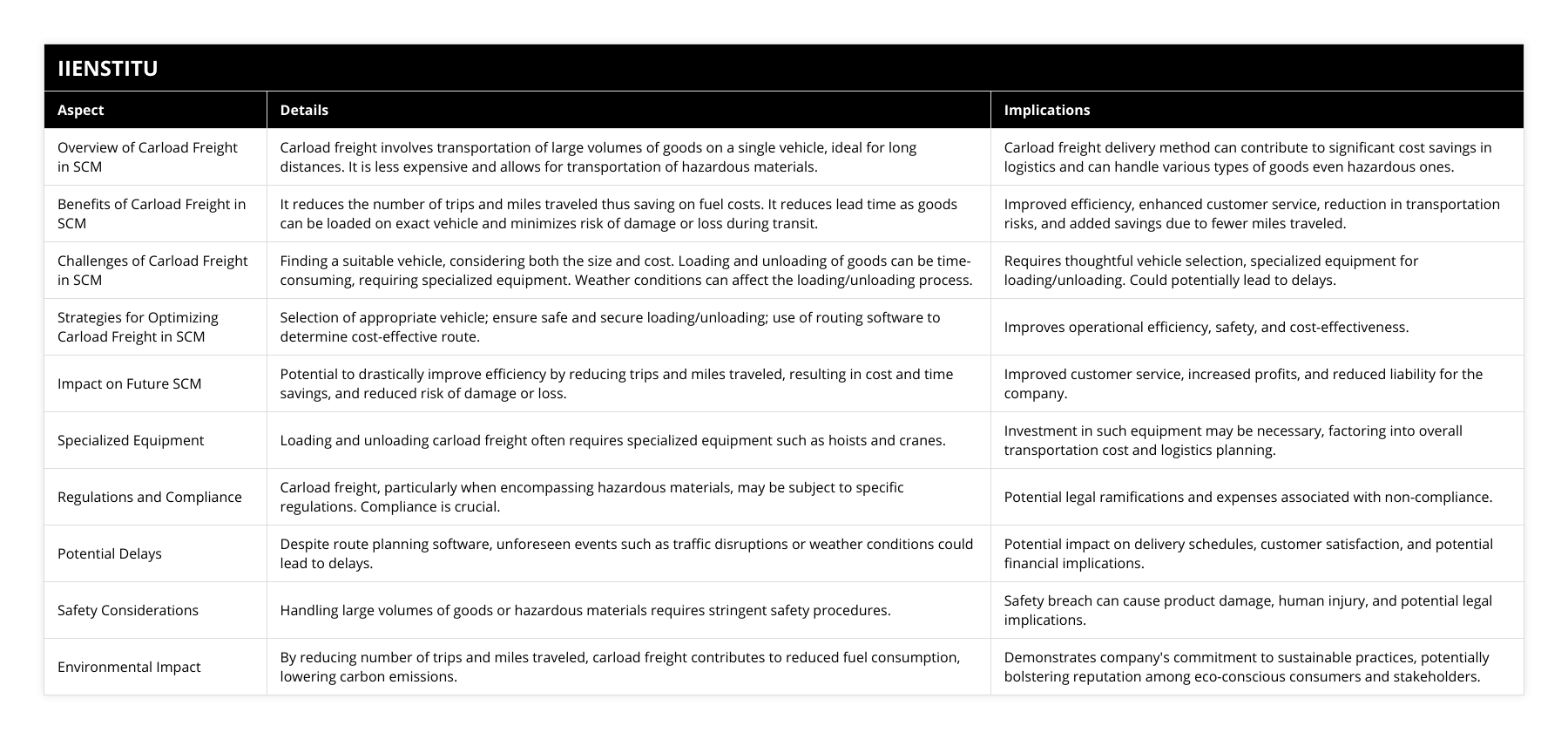
Frequently Asked Questions
What are the benefits of using carload freight in supply chain management?
Carload freight has been used to transport goods for centuries, and it is still widely used today. Carload freight is transporting goods on a large scale, with multiple pieces of cargo loaded onto one vehicle or train for transportation. This method of freight transportation offers many benefits to supply chain management, including cost savings, improved efficiency and security, and greater flexibility.
The cost savings associated with carload freight are significant compared to other forms of transportation. By consolidating goods into one load instead of shipping them separately, businesses can save money by reducing the number of shipments made. Additionally, because carload freight travels in large volumes, businesses can take advantage of carrier volume discounts, which can further reduce costs.
In addition to cost savings, carload freight offers improved efficiency and security in supply chain management. By consolidating goods into one shipment rather than many separate shipments, the risk associated with lost goods is minimized since the entire shipment arrives simultaneously. Additionally, this method of transport allows for efficient routing since it eliminates multiple stops along a route that separate shipments would require. Furthermore, it allows for faster transit times since there are fewer stops along the route and fewer chances for delays due to traffic or weather conditions.
Finally, carload freight also provides greater flexibility in supply chain management due to its ability to accommodate larger loads than traditional cargo containers. This allows businesses to adjust their inventory levels more efficiently by quickly adding or removing items from shipments, increasing product availability and customer satisfaction. Additionally, carloads are not limited by size limitations like containers, which means businesses have greater freedom when deciding how much cargo they want to transport at any given time.
Overall, carload freight has proven itself as an effective way to transport goods on a large scale while providing numerous benefits explicitly related to supply chain management, such as cost savings due to volume discounts and increased flexibility due to its ability to accommodate larger loads than traditional cargo containers provide. Furthermore, this method also offers improved efficiency and security because it consolidates multiple items into one shipment rather than shipping them separately, minimizing the risk associated with lost goods while providing faster transit times. Taking all these factors into consideration makes it clear why this form of transportation has been so popular throughout history and why it continues to remain so today
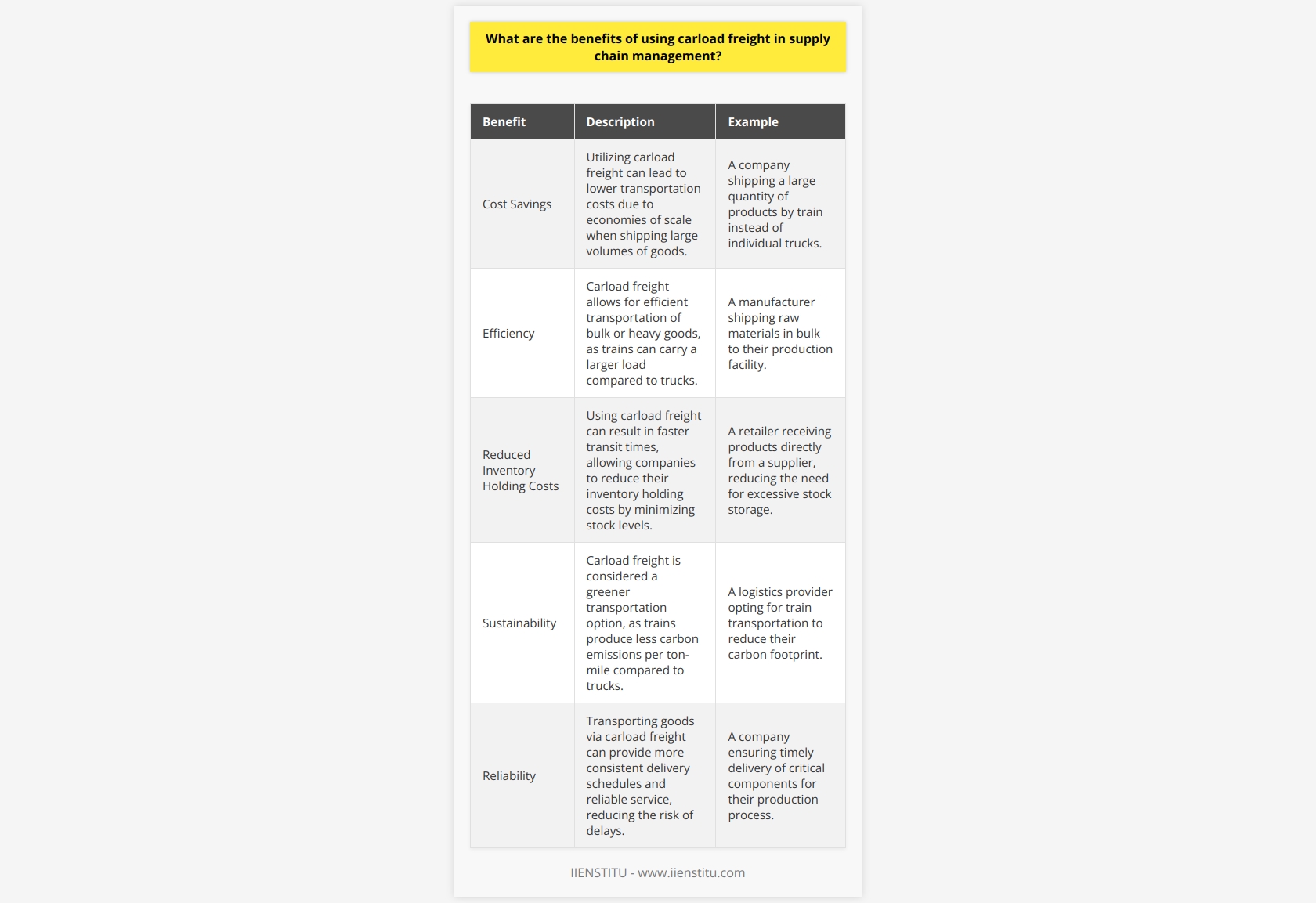
What challenges are associated with carload freight in supply chain management?
Supply chain management involves coordinating many aspects of the supply chain to ensure efficiency and cost-effectiveness. For example, carload freight, which involves transporting goods in large trucks, is integral to many supply chains. However, several challenges associated with carload freight need to be addressed to ensure a successful supply chain.
The first challenge associated with carload freight is the cost of the transport. Large trucks require a significant fuel and maintenance investment, which can be a major expense for supply chain managers. Additionally, the cost of labor to drive the trucks is also high. This can make it challenging to maintain cost-effective supply chains.
Second, carload freight often requires long transit times. This can result in delays in the delivery of goods and disrupt the supply chain. This can be especially problematic in industries where timely delivery is essential, such as the pharmaceutical industry. Long transit times can also lead to increased costs, as the truck may need to be idling for extended periods.
Third, carload freight is heavily regulated. Drivers must adhere to strict rules and regulations, such as hours of service limits and rest periods. Additionally, trucks must pass regular safety inspections. These regulations can be challenging to comply with, leading to delays and increased costs.
Finally, carload freight can be challenging to manage due to the large amount of required paperwork. For example, drivers must keep detailed logs of their trips and provide proof of delivery. Additionally, supply chain managers must monitor the trucks at all times to ensure they comply with safety regulations and meet delivery deadlines.
In conclusion, carload freight is an essential part of many supply chains. However, there are several challenges associated with it that must be addressed to ensure a successful supply chain. These include the high cost of transport, long transit times, heavy regulation, and difficulty managing the paperwork associated with it. By addressing these issues, supply chain managers can ensure their supply chains remain cost-effective and efficient.
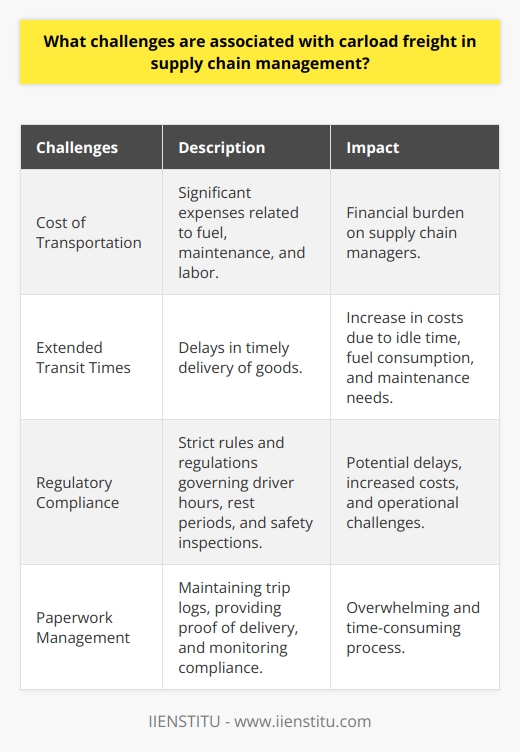
What strategies can be used to optimize carload freight in supply chain management?
Supply chain management plays a critical role in the success of any business, and carload freight is an essential part of it. Optimizing carload freight in supply chain management can help businesses reduce costs and increase efficiency in the supply chain process. This article will discuss strategies that can be used to optimize carload freight in supply chain management.
One of the most effective strategies for optimizing carload freight is to use route optimization tools. These tools can help businesses identify the most cost-effective routes for their cargo, saving time and money. Route optimization tools can also provide insights into traffic patterns, allowing businesses to adjust their delivery schedules accordingly.
Another strategy that can be used to optimize carload freight is load consolidation. This involves grouping shipments so they are all delivered simultaneously instead of multiple trips with small loads each time. Consolidation helps reduce fuel consumption and transportation costs while increasing efficiency by reducing delivery times and improving customer service.
Thirdly, telematics and sensors can help companies manage their fleets more effectively by providing real-time data on vehicle performance, fuel consumption, weather conditions, driver behavior, etc., allowing them to make informed decisions about routing and scheduling for maximum efficiency. Additionally, it allows companies to monitor cargo security along its entire journey from origin to destination.
Finally, another strategy that can be used to optimize carload freight is carrier collaboration and integration. Partnering with reliable carriers with a proven track record of delivering goods on time and safely at an agreed-upon price point can significantly improve logistics operations by reducing delays caused by unreliable carriers or inefficient processes within the supply chain network. Additionally, integrating different modes of transportation - such as roadways with rail networks - provides more flexibility when planning deliveries which further reduces delays while keeping costs down at the same time.
In conclusion, there are several strategies that businesses can employ when attempting to optimize carload freight within their supply chains, including route optimization tools; load consolidation; utilization of technology such as telematics and sensors; as well as carrier collaboration and integration. By utilizing these strategies effectively, businesses can reduce costs while increasing efficiency throughout their logistics operations, ultimately leading them toward tremendous success both now and in the future.
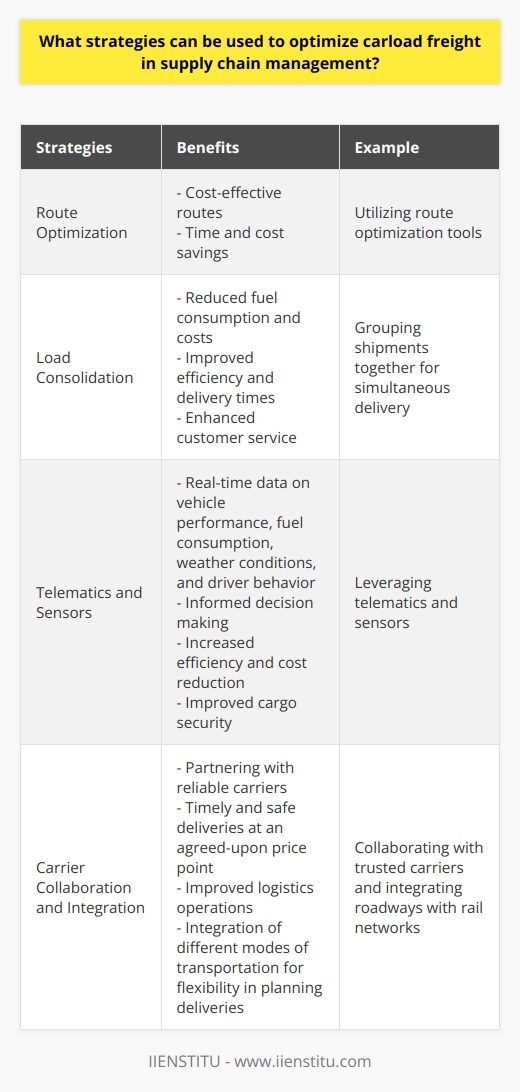
What are the top two challenges that the trucking industry are facing in today's supply chain?
Fuel Costs and Driver Shortage: Challenges in the Trucking Industry
Fuel Costs
The first major challenge the trucking industry faces is the high cost of fuel. Diesel fuel, essential for trucks, has seen volatile price changes over years. Trucks consume a lot of fuel, especially when they travel long distances. Therefore, any change in the price of fuel has a direct impact on a trucking company's profitability. Even small fluctuations can strain their margins. With no control over fuel prices, trucking businesses struggle to budget accurately. Consequently, they are left in a challenging spot where their operational expenses could skyrocket anytime.
Driver Shortage
The second challenge is the persistent shortage of trained drivers. The industry is experiencing a lack of interest in the profession among younger generations. This lack of interest is due to the stressful nature of the job, long working hours and extended periods away from home. In addition, the aging workforce is creating a vacuum as older drivers retire. Recruitment and retention thus remain constant challenges for trucking companies. Companies often have to invest in higher wages, benefits, and bonuses to attract and retain drivers, which further squeeze their profit margins.
So, the rising costs and scarcity of working force are the two most significant hurdles disrupting the smooth function of the trucking industry in today’s supply chain. Their resolution demands innovative and sustainable solutions that balance profitability with workforce satisfaction.
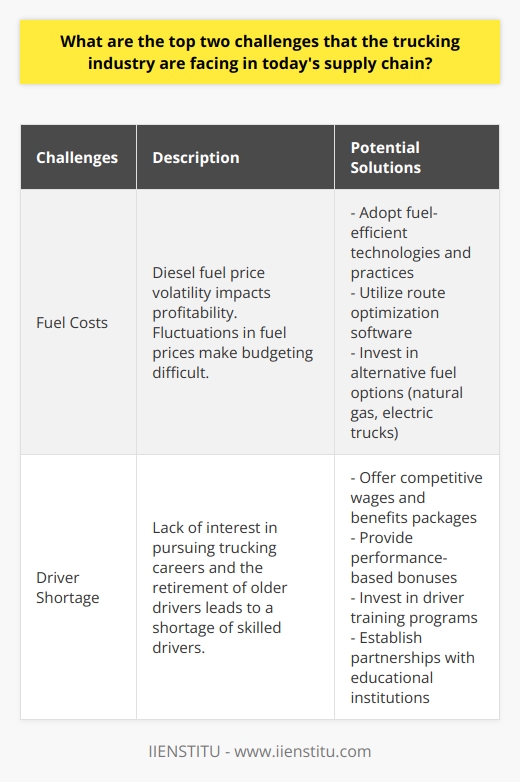
What are the key issues and challenges for logistics?
Increasing Operational Costs
A primary issue within logistics is the increasing operational costs. These costs relate to transportation, warehousing, and handling of goods. Inflation and fuel price variation heavily impact these costs.
Confronting Technology Integration
Logistics must incorporate modern technology to stay competitive. The challenge exists in integrating technologies like AI, IoT, and Big Data. Many providers struggle with the migration to digital platforms due to costs and the lack of technological proficiency.
Handling Supply Chain Complexities
Regulatory compliance also poses challenges. Ensuring adherence to global standards without compromising on delivery speed or efficiency is quite complex. These complexities increase when operating in multiple countries.
Managing Human Resources
Human resources management poses an enormous issue. The sector experiences high employee turnover and faces difficulties in attracting skilled professionals. This issue affects the consistency of logistics services.
Sustainability Matters
Environmental sustainability is a newer challenge. Pressure from governments and consumers demand ‘greener’ operations. This change involves adopting cleaner fuels or reducing packaging, which adds to operational costs.
Security Concerns
Security of goods during transit is a substantial problem. Missing or damaged goods erode profit margins and hurt company reputation. Achieving high levels of security while keeping costs down is a constant struggle.
Adapting to Customer Expectations
Both businesses and customers have increasing expectation levels. They demand faster, transparent, and more flexible services. Adapting to this requirement without significant cost increase is a significant challenge.
In conclusion, logistics face multiple issues and challenges. Each of these issues requires strategic planning and innovative solutions to overcome. Success hinges on an entity's ability to adapt and evolve in an ever-changing business environment.
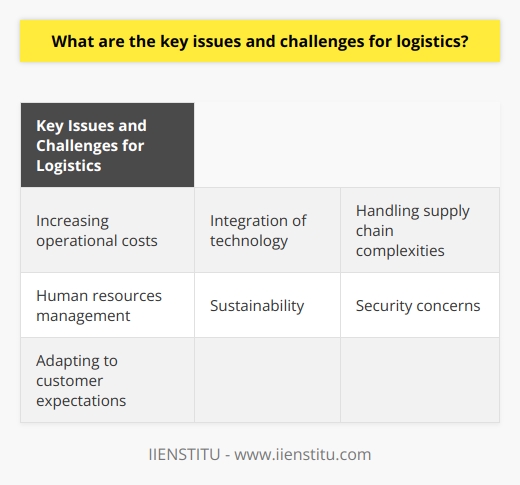
What are the 5 logistics strategies?
Five Major Logistics Strategies
Effective Strategic Planning
Effective strategic planning forms the first logistics strategy. It demands accurate forecasting of demands and careful consideration of supplier's capabilities. This strategy helps prevent supply chain disruptions and maintains efficiency.
Utilizing Just-In-Time Technique
This strategy involves delivering goods just before consumers need them. It reduces inventory costs and increases efficiency. However, this careful timing requires efficient coordination and communication within the supply chain.
Adoption of Technology
Technology impacts logistics operations significantly. It enables real-time tracking, efficient data management, and accurate forecasting. Therefore, adopting technology as a logistics strategy allows organizations to streamline processes and increase efficiency.
Maintaining Supplier Relationships
Good supplier relationships are essential for smoother operations. This strategy ensures timely deliveries and high-quality products. It also enables better communication, leading to prompt resolution of issues and efficient operations.
Implementing Green Logistics
The fifth strategy includes implementing green logistics. This involves utilizing environment-friendly methods in logistics operations. Green logistics reduces carbon footprints, increases brand reputation and results in long-term cost savings.
In short, these five logistics strategies, when properly implemented, can enhance operational efficiency, minimize costs, and promote sustainable practices within an organization.
